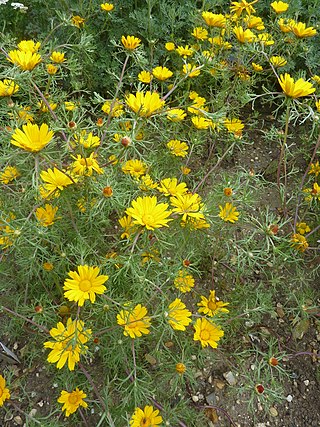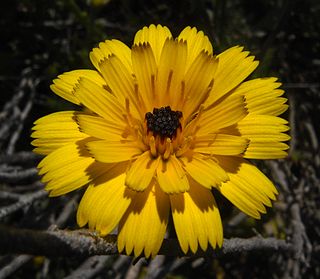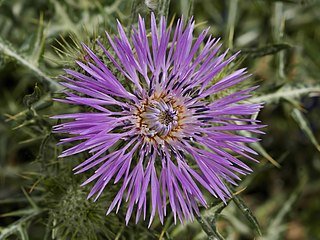
Asteraceae is a large family of flowering plants that consists of over 32,000 known species in over 1,900 genera within the order Asterales. The number of species in Asteraceae is rivaled only by the Orchidaceae, and which is the larger family is unclear as the quantity of extant species in each family is unknown. The Asteraceae were first described in the year 1740 and given the original name Compositae. The family is commonly known as the aster, daisy, composite, or sunflower family.

Cynara is a genus of thistle-like perennial plants in the family Asteraceae. They are native to the Mediterranean region, the Middle East, northwestern Africa, and the Canary Islands. The genus name comes from the Greek kynara, which means "artichoke".

Helminthotheca is a genus in the tribe Cichorieae of the family Asteraceae. Helminthotheca is closely related to the genus Picris, both within the Hypochaeridinae subtribe.

Scolymus is a genus of annual, biennial or perennial, herbaceous plants that is assigned to the family Asteraceae, and can be found in Macaronesia, around the Mediterranean, and in the Middle East. All species are spiny, thistle-like in appearance, with flowerheads that consist of yellow ligulate florets, and canals that contain latex. It is sometimes called golden thistle or oyster thistle, and is known as سكوليمس (skwlyms) in Arabic and scolyme in French.

Scorzonera is a genus of flowering plants in the tribe Cichorieae within the family Asteraceae.

Onopordum, or cottonthistle, is a genus of plants in the tribe Cardueae within the family Asteraceae. They are native to southern Europe, northern Africa, the Canary Islands, the Caucasus, and southwest and central Asia. They grow on disturbed land, roadsides, arable land and pastures.

Leontodon is a genus of plants in the tribe Cichorieae within the family Asteraceae, commonly known as hawkbits.

Crepis, commonly known in some parts of the world as hawksbeard or hawk's-beard, is a genus of annual and perennial flowering plants of the family Asteraceae superficially resembling the dandelion, the most conspicuous difference being that Crepis usually has branching scapes with multiple heads. The genus name Crepis derives from the Greek krepis, meaning "slipper" or "sandal", possibly in reference to the shape of the fruit.

Leontodon pyrenaicus is a species of hawkbit found in the Alps, Pyrenees, Cantabrian Mountains, northern Apennines and northern parts of the Balkan Peninsula. It grows in meadows and on stony slopes from the tree line to over 3000 m, usually on acidic soils. It is perennial, and flowers from June to August.

Catananche is a genus of flowering plants in the family Asteraceae. It is native to dry meadows in the Mediterranean region.

Ptilostemon is a genus of plants in the tribe Cardueae within the family Asteraceae.

Cladanthus is a genus of plants in the sunflower family, native to the Mediterranean region.

Senecio glaucus is an annual member of the Asteraceae and species of the genus Senecio. It is found from the western Mediterranean to Central Asia in sandy, well-drained soil, particularly coastal and desert dunes.

Helminthotheca echioides, known as bristlyoxtongue, is a sprawling annual or biennial herb native to Europe and North Africa. It was originally placed within the genus Picris but is often separated within the small genus Helminthotheca alongside a few other plants which also have the distinctive outer row of bracts around the flowerheads. It is a ruderal plant, found on waste ground and agricultural soils around the world, and in some places it is considered a troublesome weed.

Tolpis is a genus of flowering plants in the tribe Cichorieae within the family Asteraceae. It is native to Africa, Southern Europe, the Middle East and Macaronesia. Many species are limited to the Canary Islands.

Galactites is a genus of flowering plants in the family Asteraceae. The name is derived from the Greek γάλα. The best-known species is Galactites tomentosus.

Rhagadiolus is a genus of plants in the tribe Cichorieae within the family Asteraceae, native to the Mediterranean region of southern Europe, northern Africa, and the Middle East.

Scorzoneroides autumnalis, commonly called autumn hawkbit, is a perennial plant species, widespread in its native range in Eurasia, and introduced in North America.

Cheirolophus is a genus of flowering plants in the family Asteraceae first described as a genus in 1827. It is native to the western Mediterranean.




















